Related Research Articles

Chlorine is a chemical element; it has symbol Cl and atomic number 17. The second-lightest of the halogens, it appears between fluorine and bromine in the periodic table and its properties are mostly intermediate between them. Chlorine is a yellow-green gas at room temperature. It is an extremely reactive element and a strong oxidising agent: among the elements, it has the highest electron affinity and the third-highest electronegativity on the revised Pauling scale, behind only oxygen and fluorine.
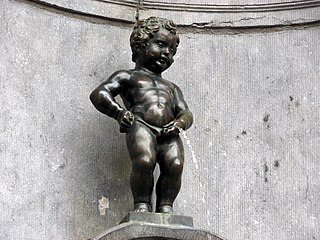
Urination is the release of urine from the bladder to the outside of the body. Urine is released from the urethra through the penis or vulva in placental mammals and through the cloaca in other vertebrates. It is the urinary system's form of excretion. It is also known medically as micturition, voiding, uresis, or, rarely, emiction, and known colloquially by various names including peeing, weeing, pissing, and euphemistically going number one. The process of urination is under voluntary control in healthy humans and other animals, but may occur as a reflex in infants, some elderly individuals, and those with neurological injury. It is normal for adult humans to urinate up to seven times during the day.

Nitrogen trichloride, also known as trichloramine, is the chemical compound with the formula NCl3. This yellow, oily, and explosive liquid is most commonly encountered as a byproduct of chemical reactions between ammonia-derivatives and chlorine. Alongside monochloramine and dichloramine, trichloramine is responsible for the distinctive 'chlorine smell' associated with swimming pools, where the compound is readily formed as a product from hypochlorous acid reacting with ammonia and other nitrogenous substances in the water, such as urea from urine.

A hot tub is a large tub full of water used for hydrotherapy, relaxation or pleasure. Some have powerful jets for massage purposes. Hot tubs are sometimes also known as "spas" or by the trade name Jacuzzi. Hot tubs may be located outdoors or indoors.
Shock chlorination is a process used in many swimming pools, water wells, springs, and other water sources to reduce the bacterial and algal residue in the water. Shock chlorination is performed by mixing a large amount of sodium hypochlorite, which can be in the form of a powder or a liquid such as chlorine bleach, into the water. The common advice is that the amount added must raise the level of chlorine to 10X the level of chloramines present in the pool water; this is "shocking". A lesser ratio is termed superchlorinating. Water that is being shock chlorinated should not be swum in or drunk until the sodium hypochlorite count in the water goes down to three ppm or less which is generally more than 6 hours. Commercial sodium hypochlorite should not be mixed with commercial calcium hypochlorite, as there is a risk of explosion. Although a verb for superchlorination, "shock" is often misunderstood to be a unique type of product.
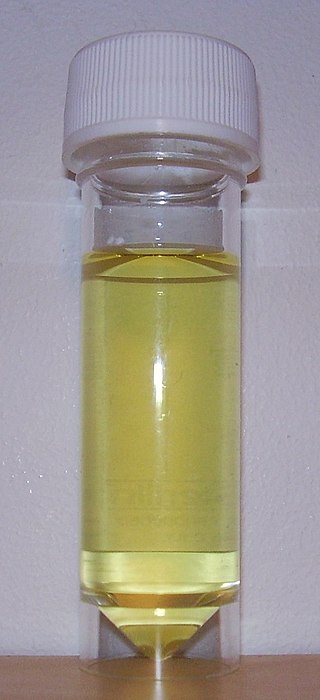
Urine is a liquid by-product of metabolism in humans and in many other animals. In placental mammals, urine flows from the kidneys through the ureters to the urinary bladder and is released from the bladder through the urethra during urination. In other vertebrates, urine is excreted through the cloaca.
Salt water chlorination is a process that uses dissolved salt for the chlorination of swimming pools and hot tubs. The chlorine generator uses electrolysis in the presence of dissolved salt to produce chlorine gas or its dissolved forms, hypochlorous acid and sodium hypochlorite, which are already commonly used as sanitizing agents in pools. Hydrogen is produced as byproduct too.
Monochloramine, often called chloramine, is the chemical compound with the formula NH2Cl. Together with dichloramine (NHCl2) and nitrogen trichloride (NCl3), it is one of the three chloramines of ammonia. It is a colorless liquid at its melting point of −66 °C (−87 °F), but it is usually handled as a dilute aqueous solution, in which form it is sometimes used as a disinfectant. Chloramine is too unstable to have its boiling point measured.

See Stock tank oil for oil industry stock tank definition.

A garden pond is a water feature constructed in a water garden or designed landscape, normally for aesthetic purposes, to provide wildlife habitat, or for swimming.
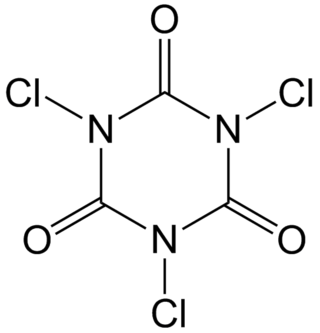
Trichloroisocyanuric acid is an organic compound with the formula (C3Cl3N3O3). It is used as an industrial disinfectant, bleaching agent and a reagent in organic synthesis. This white crystalline powder, which has a strong "chlorine odour," is sometimes sold in tablet or granule form for domestic and industrial use.

Swimming pool sanitation is the process of ensuring healthy conditions in swimming pools. Proper sanitation is needed to maintain the visual clarity of water and to prevent the transmission of infectious waterborne diseases.

Bleach is the generic name for any chemical product that is used industrially or domestically to remove colour (whitening) from fabric or fiber or to disinfect after cleaning. It often refers specifically to a dilute solution of sodium hypochlorite, also called "liquid bleach".

A swimming pool service technician is a person who maintains swimming pools, including keeping the water clean and safe by fixing pool equipment such as pumps, motors and water filters.
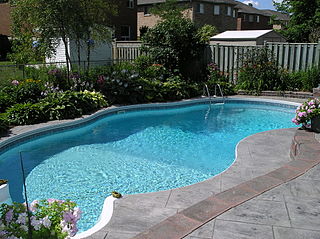
A swimming pool, swimming bath, wading pool, paddling pool, or simply pool, is a structure designed to hold water to enable swimming or other leisure activities. Pools can be built into the ground or built above ground, and may be found as a feature aboard ocean-liners and cruise ships. In-ground pools are most commonly constructed from materials such as concrete, natural stone, metal, plastic, composite or fiberglass, and can be of a custom size and shape or built to a standardized size, the largest of which is the Olympic-size swimming pool.
"Pee" is the thirteenth season finale of the American animated television series South Park. The 195th overall episode of the series, it originally aired on Comedy Central in the United States on November 18, 2009. In the episode, the boys visit Pi Pi's Splashtown, the local waterpark, where so many people urinate in the pools to the point that the entire park becomes engulfed in tsunamis of urine.
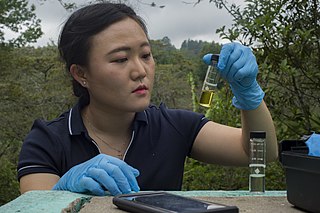
Water chlorination is the process of adding chlorine or chlorine compounds such as sodium hypochlorite to water. This method is used to kill bacteria, viruses and other microbes in water. In particular, chlorination is used to prevent the spread of waterborne diseases such as cholera, dysentery, and typhoid.
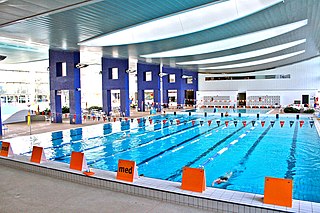
Respiratory risks of indoor swimming pools can include coughing, wheezing, aggravated asthma, and airway hyper-responsiveness. The chemicals used for pool water disinfection can react with organic compounds in the water to create disinfection by-products or DBPs. Exposure to these DBPs are the potential cause for respiratory symptoms in swimmers. Multiple studies have shown the potential correlation between chronic exposure to DBPs and respiratory symptoms among competitive swimmers but more research is needed on the effects of these DBPs on recreational swimmers. The studies on recreational swimmers that have been done show a decreased risk for respiratory symptoms due to a decreased exposure to DBPs. Some studies have been done on the vulnerability of younger children and DBP exposure. Studies done on the vulnerability of younger children demonstrate that immature lungs are more likely to absorb more of these DBPs.

Chlorine-releasing compounds, also known as chlorine base compounds, is jargon to describe certain chlorine-containing substances that are used as disinfectants and bleaches. They include the following chemicals: sodium hypochlorite, chloramine, halazone, and sodium dichloroisocyanurate. They are widely used to disinfect water and medical equipment, and surface areas as well as bleaching materials such as cloth. The presence of organic matter can make them less effective as disinfectants. They come as a liquid solution, or as a powder that is mixed with water before use.
Xing-Fang Li is a toxicologist whose research involves the discovery and identification of water contaminants through the development of new analytical technologies, as well as the engineering of solutions to ensure safe drinking water. Li is a professor at the Department of Laboratory Medicine and Pathology at the University of Alberta in Canada. She is a Canada Research Chair in Analytical and Environmental Toxicology, and was appointed as a Fellow of the Royal Society of Canada in 2021.
References
- 1 2 3 Mikkelson, Barbara (December 14, 2000). "Piscine of the Crime". Snopes. Retrieved September 18, 2012.
- ↑ Hannah Devlin (1 March 2017). "How much pee is in our swimming pools? New urine test reveals the truth". The Guardian . Retrieved 6 June 2022.
- 1 2 O'Neil, Lauren (25 June 2015). "Pee, not chlorine, causes red eyes from swimming pools: CDC". CBC News. Retrieved 26 June 2015.
- ↑ Lindsay K. Jmaiff Blackstock; et al. (1 March 2017). "Sweetened Swimming Pools and Hot Tubs". Environmental Science & Technology Letters. 4 (4): 149–153. Bibcode:2017EnSTL...4..149J. doi: 10.1021/acs.estlett.7b00043 .
- ↑ Dr Karl Kruszelnicki (2010). Curious and Curiouser. Pan Macmillan. pp. 203–207. ISBN 9781742624266.
- ↑ Sally Magnusson (2011). Life of Pee; The Story of How Urine Got Everywhere. Aurum Press. p. 143. ISBN 9781845138011.